A young Sarhentaruc mother and her daughter walk up the coast
 Monday, June 6, 2011 at 1:00AM
Monday, June 6, 2011 at 1:00AM  Drawing of Mission San Carlos de Borroméo de Carmelo by José Cardero of the Malaspina expedition in 1791.The first baptisms at Mission San Carlos de Borroméo de Carmelo came from the rancherias nearest the mission — first Achasta and Tucutnut, and then Echilat, Socorronda, and Ichxenta. Achasta was in the immediate vicinity of the mission, and Tucutnut a couple miles up Carmel Valley.
Drawing of Mission San Carlos de Borroméo de Carmelo by José Cardero of the Malaspina expedition in 1791.The first baptisms at Mission San Carlos de Borroméo de Carmelo came from the rancherias nearest the mission — first Achasta and Tucutnut, and then Echilat, Socorronda, and Ichxenta. Achasta was in the immediate vicinity of the mission, and Tucutnut a couple miles up Carmel Valley.
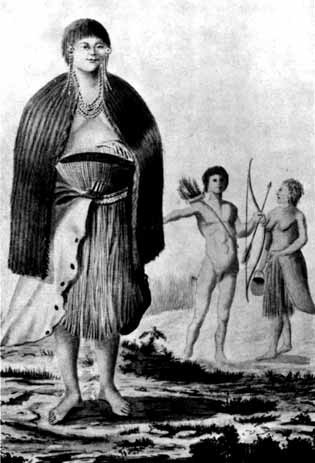
But in the summer of 1776, a young mother from Sarhentaruc appeared at the mission with her four year old daughter, and both were baptized. The previous journal refers to this mother and daughter, too — and to the location of "Pitchi in the place called Sargenta Ruc."
(Since the padres typically only recorded the native names of particularly prominent individuals, like the capitans or head-men of villages, in the majority of cases, we can only identify individuals in the mission records by their given Spanish baptismal names.)
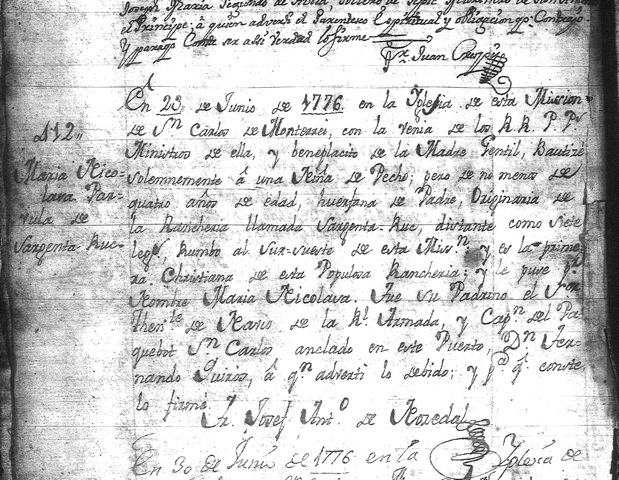
For instance, the four year old girl who was the first person ever baptized from Sargenta Ruc was christened Maria Nicolasa. She is described as "huerfana de Padre," that is, orphaned, or left unprotected, by her father. In Indians and Pioneers of Old Monterey, James Culleton refers to the girl's mother, christened Maria Josepha de la Asumpcion, as a "grass widow." This would mean that her husband hadn't died, but had left her or set her aside.
Does this explain why Maria Josepha de la Asumpcion would make the journey to the mission with her young daughter? Had she been ostracized or shamed? Did she feel there was no longer enough support for her in Sarhentaruc?
Likely, she knew friends or relatives from rancherias to the north who were already associated with the mission — people from Ichxenta or Echilat or Tucutnut.
Her daughter, Maria Nicolasa, was baptized on June 23, 1776. Seven weeks later on August 15, Maria Josepha de la Asumpcion was baptized herself. The difference in baptismal dates can be explained by the fact that as an adult Maria Josepha de la Asumpcion would have needed to receive "instruction in the faith."
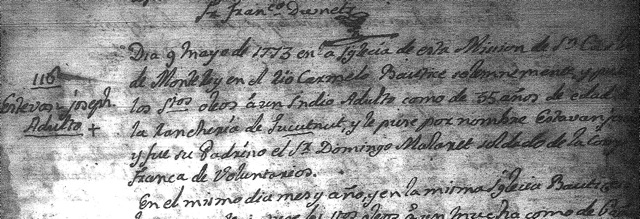
Curiously, only five days after her baptism, Maria Josepha de la Asumpcion was married to a widower from Tucutnut, Estevan Joseph Malaret.
Did the two know one another before Maria Josepha de la Asumpcion arrived at the mission? Or was theirs a hastily arranged marriage — part of the conscious attempt to keep unmarried women away from sexual encounters?
By the time Maria Josepha and her daughter had arrived at the mission from Sargenta Ruc, virtually all of Tucutnut had already been missionized. Seventy-eight people from Tucutnut had been baptized in 1773 alone, the year Estevan Joseph and his first wife, Raymunda Maria, were baptized, too, and then another thirty-eight were baptized in 1774, indicating the wholesale integration of Tucutnut into the mission system. Estevan Joseph and Raymunda were 35 and 40 years old at the time of their baptisms, and I haven't seen any mission records indicating they had children. They were already a married couple in Tucutnut before their baptisms, and their marriage record at Carmel indicates that their marriage at the mission "renewed" that earlier bond.
But Raymunda Maria died suddenly in July 1775 — the year before Maria Josepha de la Asumpcion appeared and Estevan Joseph remarried.
During these earliest years, not many neophytes lived at the mission itself. The mission wasn't yet prepared agriculturally and economically to support such a population — and the first neophytes came from nearby rancherias anyway. These rancherias quickly assumed Spanish names, likely indicating that they had been thoroughly christianized. For instance, Tucutnut soon began to be called "Santa Theresa, alias Tucutnut" in the Carmel mission records. Most likely, this is where Maria Josepha de la Asumpcion and Maria Nicolasa lived with Estevan Joseph because in her death record, Maria Josepha's place of origin is no longer given as "Pitchi in the place known as Sargenta Ruc," but rather as "Tucutnút. alias Santa Therez."
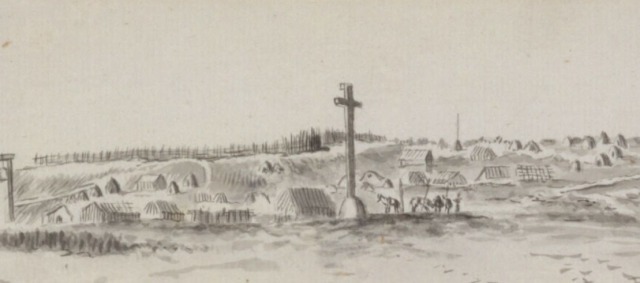 Detail of José Cardero's drawing of Carmel mission in 1791.This would change, of course. For example, in this detail of José Cardero's drawing of the mission in 1791, you can recognize the tule houses of native people in the background. If you click on either this image or his full drawing further above, you can scroll and zoom into Cardero's drawing on your own.
Detail of José Cardero's drawing of Carmel mission in 1791.This would change, of course. For example, in this detail of José Cardero's drawing of the mission in 1791, you can recognize the tule houses of native people in the background. If you click on either this image or his full drawing further above, you can scroll and zoom into Cardero's drawing on your own.
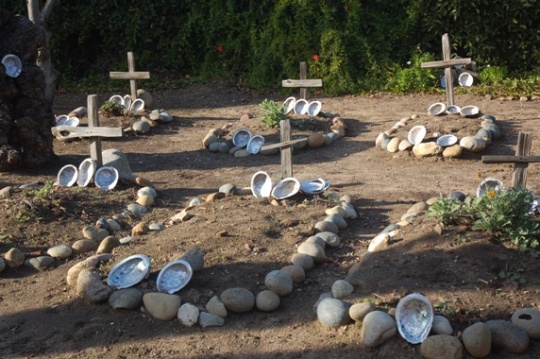 Photo courtesy of Christopher Reynolds of the LA Times.
Photo courtesy of Christopher Reynolds of the LA Times.
In less than four years, however, Maria Josepha, Maria Nicolasa, and Estevan Joseph would each die in rapid succession. Maria Josepha died in December 1779 at the age of 25. Her daughter Maria Nicolasa died three months later. She was 8. And Estevan Joseph died three months after the young girl — in May 1980.
By 1781 the padres at Carmel had baptized 625 native people — and they had buried 215 of them. When you consider that 376 of the 625 baptisms were infants or children 14 or younger, and that only 26 of the baptisms were adults over 40, the death rate becomes even more horrifying.
Whether you were a native person at the mission itself, or were still living in your own village after contact with the Spanish, you had no natural resistance to diseases like smallpox that the Spanish had brought with them.
Since she died in 1775, Raymunda Maria, Estevan Joseph's first wife, was buried in the earlier mission church. But the bodies of Maria Josepha de la Asumpcion, her daughter Maria Nicolasa, and Estevan Joseph are buried somewhere in the Carmel mission cemetery grounds.
__________________________
Note
Baptized native people also were given the surname of their padrino, or godfather. Thus, the husband's name above is Estevan Joseph Malaret since his padrino was Domingo Malaret, one of the company of Catalan volunteers in Monterey. Maria Josepha de la Asumpcion's godparents were Petra Ochoa and Augustin Valenzuela, the latter a soldier who had come in the De Anza expedition. Perhaps Petra Ochoa had come then, too.

Reader Comments